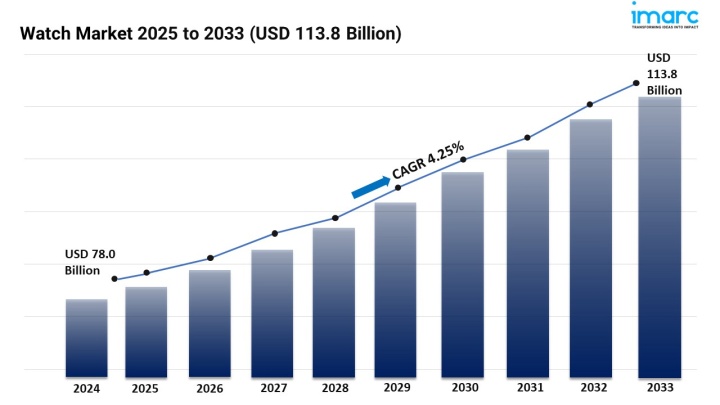

Market Overview:
The watch market is experiencing rapid growth, driven by Rising Demand for Luxury Watches, Surge in Smartwatch Adoption and Growing Disposable Incomes in Emerging Markets. According to IMARC Group's latest research publication, "Watch Market Size, Share, Trends and Forecast by Type, Price Range, Distribution Channel, End User, and Region, 2025-2033", The global watch market size was valued at USD 78.0 Billion in 2024. Looking forward, IMARC Group estimates the market to reach USD 113.8 Billion by 2033, exhibiting a CAGR of 4.25% during 2025-2033.
This detailed analysis primarily encompasses industry size, business trends, market share, key growth factors, and regional forecasts. The report offers a comprehensive overview and integrates research findings, market assessments, and data from different sources. It also includes pivotal market dynamics like drivers and challenges, while also highlighting growth opportunities, financial insights, technological improvements, emerging trends, and innovations. Besides this, the report provides regional market evaluation, along with a competitive landscape analysis.
Download a sample PDF of this report: https://www.imarcgroup.com/watch-market/requestsample
Our report includes:
Growth Factors in the Watch Industry:
The global watch market is thriving as luxury watches gain popularity, driven by their status as symbols of style and success. Asia Pacific holds a 33.7% market share, fueled by growing wealth in China and India, per the source. Rolex’s new Dubai boutique, the largest in the region, caters to affluent buyers, per the source. Social media on X buzzes with luxury watch trends, engaging high-end consumers. Urban elites drive demand, but emerging markets like Brazil need affordable options. Government initiatives, like India’s PLI scheme for manufacturing, boost local production. Luxury watches, with 60% of sales, offer exclusivity, appealing to millennials seeking personalized, high-end timepieces.
Smartwatches are fueling the global watch market with their health and connectivity features, appealing to tech-savvy consumers. Over 200 million smartwatches are in use globally, with the U.S. accounting for 45% of wearable tech users, per the source. Apple’s Series 10, with advanced heart rate and sleep tracking, drives sales, per the source. Social media on X highlights smartwatch trends, engaging fitness enthusiasts. Urban markets lead, but rural adoption grows with e-commerce. Government health campaigns, like Singapore’s National Steps Challenge, encourage wearable use. Smartwatches, blending style and function, cater to younger demographics, boosting market growth as consumers prioritize wellness and seamless smartphone integration.
Rising incomes in emerging economies like China and India are powering the global watch market, with Asia Pacific contributing 33.7% of revenue, per the source. China’s middle class, now 30% larger, drives demand for premium watches, per the source. Titan’s expanded product line targets India’s growing middle class, per the source. Social media on X showcases luxury goods trends, engaging affluent buyers. Urban centers dominate, but tier-2 cities show potential. Government policies, like China’s tax cuts on luxury goods, spur spending. Consumers seek watches as fashion statements, boosting both luxury and mid-range segments, especially in fast-growing markets with young, style-conscious populations.
Key Trends in the Watch Market
Luxury brands are increasingly merging traditional craftsmanship with modern technology, creating “smart-luxury” hybrids that appeal to both collectors and tech enthusiasts. Companies like TAG Heuer, Montblanc, and Hublot are launching connected watches that feature health tracking, GPS, and smartphone integration—without compromising on elegance or brand heritage. These smart-luxury watches target professionals seeking functionality within luxury aesthetics. The blend of advanced technology and timeless design is redefining luxury, with digital connectivity becoming a new marker of sophistication in the premium segment. This hybrid evolution is reshaping consumer expectations and expanding luxury watch market appeal.
Personalization is becoming a key differentiator in the global watch industry. Brands are offering customizable options—such as interchangeable straps, engraved dials, and exclusive materials—to appeal to consumers seeking individuality. Limited-edition collections tied to cultural events, collaborations, and iconic personalities are also driving buzz on social media. For example, Omega’s special-edition Speedmaster collaborations have become viral collectibles, attracting both traditional collectors and younger buyers. This trend not only enhances customer engagement but also strengthens brand loyalty through exclusivity and emotional connection, particularly in the luxury and mid-range categories.
Subscription-based and pre-owned watch platforms are transforming how consumers access and own watches. Platforms like WatchBox and Chrono24 allow customers to buy, trade, or lease premium watches, making high-end timepieces more accessible. The growing acceptance of circular economy models among Gen Z and millennials is boosting the resale market, as buyers seek value, authenticity, and sustainability. Subscription services also appeal to consumers who prefer variety and flexibility over ownership. This trend reflects a shift toward experience-driven consumption and responsible luxury, reshaping purchasing behavior across both developed and emerging markets.
We explore the factors driving the growth of the market, including technological advancements, consumer behaviors, and regulatory changes, along with emerging watch market trends.
Leading Companies Operating in the Global Watch Industry:
Watch Market Report Segmentation:
By Type:
Quartz represented the largest segment as it offers enhanced accuracy and reliability.
By Price Range:
Low-range accounts for the largest market share due to its affordability.
By Distribution Channel:
Offline retail stores exhibit a clear dominance in the market as they allow people to physically try watches before making a purchase.
By End User:
On the basis of end user, the market has been divided into men, women, and unisex.
Regional Insights:
Asia Pacific enjoys a leading position in the watch market on account of the rising demand for luxury products among individuals.
Note: If you require specific details, data, or insights that are not currently included in the scope of this report, we are happy to accommodate your request. As part of our customization service, we will gather and provide the additional information you need, tailored to your specific requirements. Please let us know your exact needs, and we will ensure the report is updated accordingly to meet your expectations.
About Us:
IMARC Group is a global management consulting firm that helps the world’s most ambitious changemakers to create a lasting impact. The company provide a comprehensive suite of market entry and expansion services. IMARC offerings include thorough market assessment, feasibility studies, company incorporation assistance, factory setup support, regulatory approvals and licensing navigation, branding, marketing and sales strategies, competitive landscape and benchmarking analyses, pricing and cost research, and procurement research.
Contact Us:
IMARC Group
134 N 4th St. Brooklyn, NY 11249, USA
Email: sales@imarcgroup.com
Tel No:(D) +91 120 433 0800
United States: +1–201971–6302
